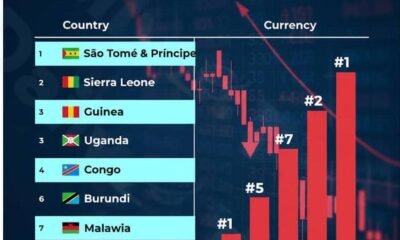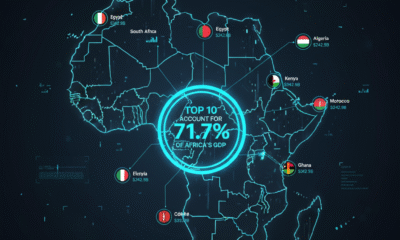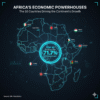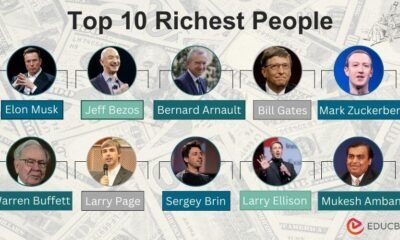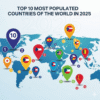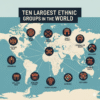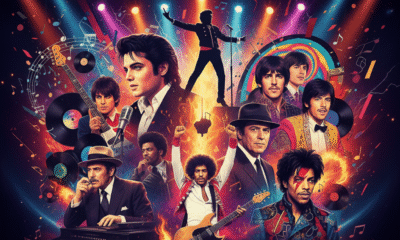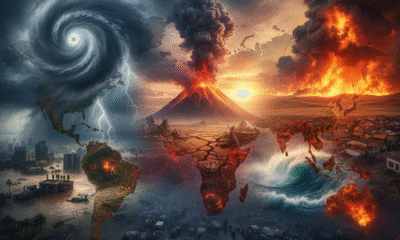Economy
Top 10 Largest Ethnic Groups in the World
The world is a mix of many different people and cultures. These groups of people are called ethnic groups. They are united by a shared history, family, and way of life. These groups shape nations and have a big impact on the world.
But which of these groups are the largest? Who are the demographic giants that make up significant portions of the global population? This article looks into the largest ethnic groups in the world.
- Man climbs electricity mast in attempted suicide
- Top 10 Most Populated Countries of the World in 2025
The article looks at their numbers, their locations, their physical features, their beliefs, and their cultural influence.
1. Han Chinese
Population: 1.4 Billion
The Han Chinese are the largest ethnic group in the world. They make up about 18% of the global human population. The vast majority of Han people live in China and Taiwan. They also have a large diaspora in countries like Singapore, Malaysia, and the United States. They are a defining force in both Asia and the world.
The Han are an East Asian ethnic group. They have their ancestral origins in the Yellow River region of China. Over thousands of years, they expanded their territory and culture. They built powerful empires and created a civilization known for its innovation. Their religious practices are a mix of Buddhism, Taoism, and ancient folk beliefs. Many people also practice Confucianism. It is a philosophy that teaches respect for family and community.
The Han Chinese are widely known for their resilience, hard work, and deep respect for tradition. Their culture has a long history of achievements in art, science, and philosophy.
The Han language, especially Mandarin Chinese, is spoken by more people than any other language. It is the official language of China and is a major language in global business, diplomacy, and education. It also gives access to thousands of years of literature and history.
2. Arabs
Population: 470 Million
The Arabs are the second-largest ethnic group in the world. They are a diverse group found mainly across the Middle East and North Africa. Arab identity is more about culture and language than it is about a specific racial background. They trace their origins to the Arabian Peninsula. They are unified by the Arabic language and a shared cultural history.
Arabs’ physical features vary greatly, from the light-skinned people of the Levant to the darker-skinned people of North Africa and the Arabian Peninsula.
The majority of Arabs are Sunni Muslim. There are also significant Shia Muslim communities. Christian minorities have existed in the region for centuries, particularly in countries like Lebanon, Syria, and Egypt.
The reputation of the Arab people is rooted in their rich history as pioneers of science, mathematics, and philosophy. During Europe’s Dark Ages, Arab scholars preserved and advanced human knowledge. They made groundbreaking discoveries in medicine, astronomy, and algebra.
The Arabic language is a pillar of Arab identity. It is the language of the Quran. This makes it central to the Islamic faith. It is spoken by hundreds of millions and is one of the six official languages of the United Nations. Its influence goes far beyond the Arab world. It has given many words to languages like Spanish, English, and Portuguese. Its flowing script and complex grammar have also influenced art and calligraphy.
3. Bengalis
Population: 275 Million
The Bengali people are primarily in the Bengal region of South Asia. This area is now divided between Bangladesh and the Indian state of West Bengal. As an Indo-Aryan group, Bengalis share a common ancestry with other people of the Indian subcontinent. Their culture is known for its deep connection to the land and rivers of the Ganges Delta.
The population is split by religion. The majority of Bengalis in Bangladesh are Muslim. Most in West Bengal are Hindu. This religious diversity has shaped their history and traditions. The Bengali people have a reputation for their immense contributions to literature, art, and music. Nobel laureate Rabindranath Tagore, who wrote the national anthems of both India and Bangladesh, is a prime example of their literary genius.
The Bengali language, Bangla, is one of the most spoken languages in the world. It is the official language of Bangladesh and the state language of West Bengal.
4. Hausa
Population: 135 Million
The Hausa are a large and influential ethnic group in West Africa. Their homeland is in Northern Nigeria and Southern Niger. They are a culturally diverse group with a mix of physical features common in the region. They are united by their shared language, culture, and history of trade.
The vast majority of Hausa people are Muslim. Islam came to the region centuries ago and became a central part of their identity. The Hausa have a reputation as shrewd merchants and traders. Their historical trade routes stretched across the Sahara, connecting West Africa with the Mediterranean and the wider Muslim world. They built powerful city-states and kingdoms known for their learning and commerce.
The Hausa language is one of the most important in Africa. It is spoken by over 135 million people. Many people use it as a lingua franca, or a bridge language, for trade and communication across West Africa. The influence of the Hausa language is major. It is a major language in media, music, and business throughout the region.
5. Punjabis
Population: 130 Million
The Punjabi people are from the Punjab region. This area is divided between Pakistan and India. Their physical appearance is a mix of Indo-Aryan and other influences, giving them diverse features. They are known for their strong and lively nature.
The Punjabi people have a unique mix of religions. Many are Sikh, with Sikhism originating in the Punjab region. Others are Muslim or Hindu. This religious diversity reflects their history as a crossroads of cultures and faiths.
The Punjabi people have a reputation for being hard-working, courageous, and full of life. They are known for their vibrant folk music, called Bhangra, and their rich cuisine.
The Punjabi language is spoken by about 130 million people. It has an immense influence on music, dance, and culture. Punjabi music is popular not only in South Asia but also around the world.
6. Japanese
Population: 125 Million
The Japanese people are an East Asian ethnic group native to the Japanese islands. Their physical features are a reflection of their unique ancestry. Their religious beliefs are a mix of Shintoism and Buddhism. They have strong ties to nature and tradition.
The Japanese people have a reputation for their strong work ethic, discipline, and high-tech innovation. They have produced great artists, philosophers, and engineers. Their culture has a unique and highly refined aesthetic, seen in everything from tea ceremonies to modern design.
The Japanese language is spoken by over 125 million people. Its influence is global, especially in technology, animation, and video games. Words like “karaoke,” “sushi,” and “manga” have become part of languages around the world.
7. Mexicans (Mestizos)
Population: 120 Million
The Mexican people, particularly the Mestizo population, are from Mexico. They are a large group of people with a mix of Indigenous and Spanish ancestry. Their physical features are a blend of both heritages. The vast majority of Mexicans are Roman Catholic, a result of centuries of Spanish influence.
Mexican people have a reputation for their warm hospitality, strong family values, and vibrant culture. Their history is a mix of ancient civilizations and colonial power. It has given them a unique blend of traditions, art, and music.
The Spanish language is a key part of Mexican identity. It is spoken by over 120 million people in Mexico. Its influence is massive, especially in the United States and other parts of the world. It has created a rich body of literature, music, and film.
8. Russians
Population: 120 Million
The Russians are the largest Slavic ethnic group. Most of them live in Russia. There are also many Russian communities in countries that were once part of the Soviet Union. Their physical features are typical of Eastern Europe.
The main religion of the Russian people is Orthodox Christianity. It has played a big role in their history and culture. The Russian people have a reputation for their resilience and intellectual and artistic genius. Russian writers, composers, and scientists have had a massive impact on the world.
The Russian language is one of the most spoken languages in the world. It is a major language of science, diplomacy, and art. The language has influenced the culture of many countries in Eastern Europe and Central Asia.
9. Javanese
Population: 115 Million
The Javanese are the largest ethnic group in Indonesia. They are native to the island of Java. Their physical features are typical of Southeast Asia. Most Javanese people are Muslim, though their culture still has some Hindu-Buddhist influences.
The Javanese people have a reputation for their highly refined art and etiquette. Their culture is known for intricate art forms like batik and wayang kulit shadow puppetry. They have a strong sense of community and social hierarchy.
The Javanese language is spoken by over 115 million people. It is a major language in Indonesia, even though the national language is Indonesian. Its influence is big in music, art, and traditional ceremonies.
10. Filipino (Tagalog & Visayan groups)
Population: 110 Million
The Filipino people are a diverse group of Austronesian people from the Philippines. The two largest groups are the Tagalog and Visayan people. Their physical appearance reflects a mix of Austronesian, Spanish, and other influences. Most are Roman Catholic.
Filipino people have a reputation for being warm, hospitable, and family-oriented. Their history is marked by a mix of indigenous traditions and colonial rule. This has created a unique culture that blends East and West.
The Philippines has many languages. The national language is Filipino, which is based on Tagalog. The Visayan languages are also widely spoken. The influence of these languages is strong in the country and in the global diaspora.


